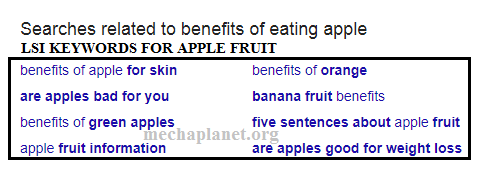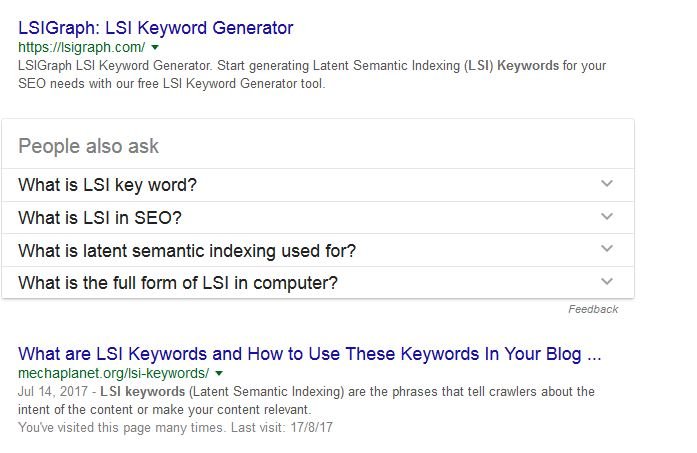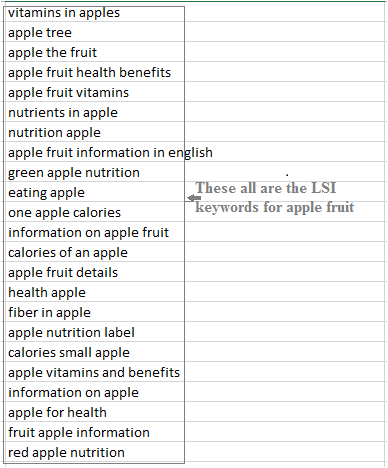A few years ago Google used meta keywords to find content relevancy. But bloggers started misusing it. They used to put a high density of keywords in their article. That’s why Google’s spiders are confused and start showing the worst results. But after researching Google introduced a new term LSI keywords that helped users to find relevant content.
What are LSI Keywords?
LSI (Latent Semantic Indexing) keywords are the words & phrases that tell crawlers about the intent of the content. These are the synonyms or related words that you can use in your content in the place of a keyword to enhance content relevancy.
OR
It is a method to convince the search engine.
According to searchenginejournal.com LSI (latent semantic index) is a mathematical method used to recognize the terms and concepts in content.
Here you may notice that in the first definition I have written the LSI keyword and in the second only LSI. It sounds weird, isn’t it?
Let me make you clear why I do so because there is a little difference between the LSI keyword & LSI. A latent semantic index is a method, but an LSI keyword is a word or phrase used to increase post relevancy.
If your page includes some semantic keywords, the search engine understands that your content is very much related to your title tag and search query.
So, it is a good practice to include these phrases on your page to make it easily understandable for the search engine. LSI keywords help to limit keyword stuffing.
Let me give you an example for a better understanding
let’s take the example of Apple.
If I ask you about Apple, you can not answer it because you don’t know the context of this query. You can either think about fruit or Apple iPhone. Eventually, you get confused due to the lack of semantic keywords.
But now if I ask you “what are the benefits of eating Apple“. Then You can answer it. Because here I have added the semantic words which increase the content relevancy.
It means if you are writing a post on the topic “Apple”. Then you can include the following terms and phrases in your post to increase your content relevancy.

Similarly, you can also enlist results for Apple iPhone.


From the above example, you can say that content relevancy is the most common factor to consider.
Take another example, LSI (latent semantic indexing) and LSI (Large-scale integration). These two words are pretty similar, and even people can’t understand if you ask only about LSI.
When I searched for LSI in Google, I found LSI industries. Which is different from ‘latent semantic indexing. What does it mean? It means that Google always shows you the most popular results even you are looking for a different result.

Now if I add ‘keywords’ along with the LSI, then it specifies the intent of this query. This new phrase enhances the search intent. So, now if I search for LSI keywords instead of LSI. I can see the desired results.

See another example for further explanation
Why is it essential to use LSI keywords in your content?
- It helps search engines to recognize the context of the content.
- It reduces keyword stuffing.
- It brings naturality to your content that increases readability.
- Increase SEO score.
- Users & search engines can easily understand the context of your content.
How to find LSI keywords for your content
It’s time you saw some words and phrases that act as semantic keywords and help you to increase content in-deepness.
You can find these keywords & phrases by using latent semantic indexing tools. There are many LSI tools that you may use for free.
#1. Google search
You can use this tool to find LSI keywords when you enter a query in the Google search bar. It automatically shows you some related phrases that you can include in your article.
Now, let us see how to do it.
Let’s take the earlier example of “Apple“. Google search shows you the following results.

As I have earlier described that to distinguish these keywords you need to use semantic words, For example, the keyword Apple is either used to define the mobile device or fruit.
So, to differentiate both things you can include some additional words and make your keyword more sophisticated like the LSI keyword.
If you are writing a post on Apple mobile, place semantic keywords like Apple iPhone, iPhone price in the US, etc. You can also find some more results by scrolling down to the bottom.

But if you are writing about Apple fruit, you can place these phrases given below.

Now, I am damn sure you become much familiar with the term Latent semantic indexing. But there is also a little confusion between the LSI keyword & long tail keyword.
LSI are synonyms, but long tail keywords indicate the length of keywords.
All the tools used to do keyword research are also used as the latent semantic indexing tool.
How to insert LSI keywords inside your blog post
There is no exact way to use these words in your copy. But the best way that I realize this is by writing naturally. Because original copywriting automatically inserts similar words & phrases.
Nevertheless, there are many ways to include these phrases. You can use my technique.
First of all, you need to find a topic on which you are going to write.
Now, go ahead and start researching that topic. Researching means reading already published content on the internet related to your topic. After completing research, you will become comfortable & able to figure out in-depth-ness of the context of copy.
Now, you know what your topic is all about. So, it is time to prepare your title tag, focus keyword, and start looking at the synonyms for that keyword.
For example, if you have picked the keyword of Apple fruit, you don’t need to put this simple keyword again and again in your copy. Because it looks so wired using the same word unnaturally.
Instead of keyword stuffing include some relevant words & phrases that make sense. But the problem is where do you grab synonyms?
It is pretty simple as I told you that before writing an article it is convenient to do research. Because it also helps you to understand the composition of the copy. By researching, you can accumulate a list of LSI keywords.
For more LSI word collection you can use latent semantic indexing tools like Google keyword planner to find related terms.
Let’s see how you can perform it.
First of all, put your absolute keyword on the search panel and hit enter.
Here you find keyword matrices and also the LSI keywords at the bottom.


These all are the semantic words that you can use to frame your article.
You can frame your post title, SEO description, headings & subheadings with the help of these words. Please, never overuse these words in your copy, go naturally.
Here you have gotten a rough idea of framing. Now, it’s time to include these related words in your paragraph.
I have written a paragraph on “apple fruit,” using proper LSI words. Let’s have a look.

Now, I believe that you have understood the Latent keyword framing process.
Conclusion
At the end of this lesson, I think that content formatting is the best part to create informative and relevant content.
From the above information, I have concluded that LSI is directly related to content relevancy and content relevancy is directly related to SEO.
So,
LSI = content relevancy + SEO + search engine readability.
If you like this post, please do share on Facebook, Twitter & LinkedIn.
Save
Save







3 thoughts on “What are LSI Keywords and How to Use These Keywords In Your Blog Post”
of course this article will help of newbie blogger. you have written this article because you have gone trough the situation as new. really helpful for new comers. thanks for sharing.
Thank you so much for sharing this useful resource! I have subscribed and waiting to receive more helpful ideas and skills.
Thanks for your kind words. it means a lot to me. stay in touch!